Peru
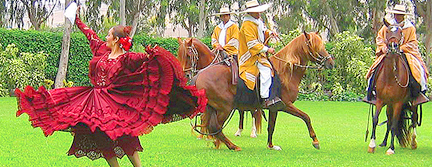 Tour historic Lima and travel by train from Cusco back in time to the ancient ruins of Machu Picchu, high in the Andes mountains; to one of the oldest civilizations in Latin America.
Tour historic Lima and travel by train from Cusco back in time to the ancient ruins of Machu Picchu, high in the Andes mountains; to one of the oldest civilizations in Latin America.
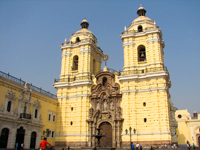 Lima
Lima
The “City of Kings,” established by the Spanish explorer Pizarro in 1535 on the site of Incan and other Amerindian settlements. Tour colonial and modern Lima, including the fascinating Larco Herrera Museum, an 18th-century mansion that is now home to a collection spanning more than 4,000 years of pre-Columbian history.
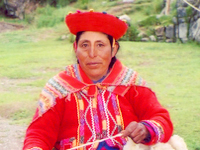 Cusco
Cusco
Tour the Sacred Valley of the Incas and Pisac’s bustling market. Try your bartering skills for sweaters, ponchos, wall hangings, jewelry and other local goods. Visit the town of Chincheros where you learn how wool is shorn from the llamas and alpacas and then spun, dyed and woven to produce a range of beautiful products.
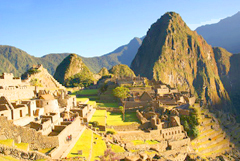 Machu Picchu
Machu Picchu
Explore the citadel’s ruins and feel its pulse as you visualize the lives of the priests, craftsmen and servants who once inhabited this city. Excavations revealed skeletons, artifacts and woolen clothing, but no hint as to the secret of its lost people; the Incas left no written record.
Click Here For More Information on Peru
Peru & Bolivia Tour
Wonders await at every turn, from colonial Lima and Cusco, to the Sacred Valley of the Incas and Machu Picchu to Lake Titicaca to La Paz. Discover ancient Inca strongholds and sacred sites surrounded by the majestic Andes Mountains. Admire the skill and craftsmanship of ancient artisans whose true medium was gold. Learn the secrets of the Sacred Valley and Machu Picchu, and have your journey blessed by a local shaman. See the incredible Nazca Lines – only visible from the air. Attend a folkloric performance based on Inca mythology. Chug through spectacular Andean scenery on a vintage rail car. Meet locals living like their ancestors did on floating reed islands on Lake Titicaca. Watch a Peruvian chef and famous Peruvian horses – demonstrate their skills.
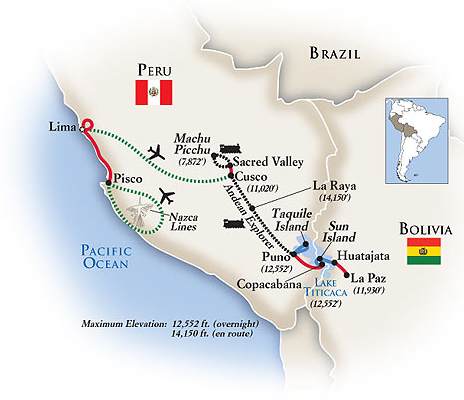
Day 1 – Welcome to Peru
Your Bolivia and Peru tour begins in Lima. Upon arrival at Lima’s Jorge Chavez International Airport, you’ll be met by a representative and transferred to your Hotel, your home for your first three nights.
Day 2 – Lima “City of Kings” 
Your Peru tour begins in the lovely colonial center of Lima, originally mapped out by Spanish conquistador Francisco Pizarro, which appears on UNESCO’s World Heritage List. You’ll be inspired by its age-old beauty and venerable traditions. Some of Lima’s most historic buildings surround the splendid Plaza Major – see the Archbishop’s Palace, with its fine carved balcony; the opulent Government Palace, the official residence of the president of Peru; and the 17th-century Church of San Pedro, an excellent example of Peruvian Baroque architecture. Visit the impressive, 16th-century Cathedral of Lima, whose first stone was laid by Pizarro himself in 1535, and in which he is buried. Get a sense of what life was like for the wealthy of Lima centuries ago during lunch at Casa de Aliaga, a beautifully preserved colonial mansion that has been owned by the same family for 17 generations; then visit the privately owned Museo Larco, housing one of the world’s largest collections of pre-Columbian artifacts.
Day 3 – Culture & Cuisine
Discover Lima’s rich artistic heritage – representing some 3,000 years and a mix of cultures including pre-Hispanic, colonial and contemporary Peruvian art – on the morning’s walking tour of the city’s “Bohemian” district, Barranco, followed by a visit to one of Lima’s fine art museums with a local guide. Enjoy lunch at Cala, a local seaside restaurant that’s truly one of Lima’s spots to “see and be seen,” where you’ll sample authentic Peruvian cuisine – a tantalizing fusion of Andean and Spanish flavors. Or you may choose to join us for an optional, full-day excursion to see the amazing Nazca Lines from the air! You’ll drive across one of the driest deserts on Earth along part of the Pan American Highway to Pisco, where you’ll take off on a flight-seeing trip to observe these massive animal figures, visible only from the air, carved into the desert floor many centuries ago by the Nazca people.
Day 4 – Sacred Valley 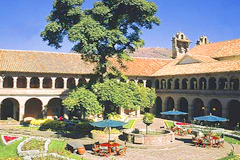
A short flight takes you from Lima to Cusco; continue overland to the Sacred Valley of the Incas for a two-night stay. South America’s iconic llama and the ubiquitous camel of the Middle East are both camelids – and thus “kissing cousins” – although they live half a world apart. That’s just one fact you’ll learn when you meet the llamas, alpacas, vicuñas and guanacos that are so associated with the Andes during a visit to the Awanacancha farm that raises them. Enjoy lunch and an equestrian demonstration starring famous Peruvian Paso horses en route to your Sacred Valley hotel.
Day 5 – Inca Mysteries
Like Egypt’s pyramids, mystery surrounds the construction methods used to build the massive stone fortress of Ollantaytambo. One of the best preserved of the Inca settlements, this living museum reveals much about what life was like here in the 15th century during a tour; the people still practice a very traditional lifestyle, as you’ll discover on a visit to a private home. Return to your hotel for a demonstration of Peruvian cuisine preparation by a chef, followed by a scrumptious lunch. Later, meet a local shaman who will bless your journey and share insights on the spiritual nature of Machu Picchu and the Sacred Valley. Tonight, you’ll be treated to a performance of The Apus of the Andes, representing Quechua lore and Inca mythology, by the folk-arts group Kusiwasi, followed by dinner.
Day 6 – Rail to Machu Picchu 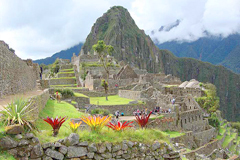
Board the Vistadome train in Ollantaytambo and travel through mist-shrouded peaks that the Incas believed to be sacred to Aguas Calientes, gateway to the “lost city of the Incas,” Machu Picchu. Spending the afternoon exploring this incredible UNESCO World Heritage Site, recently named one of the “New Seven Wonders of the World,” with our local guides will be an unforgettable highlight of your Peru tour. Inspiration is everywhere amidst the architectural and aesthetic genius evidenced in the palaces, temples, houses and baths of this mountaintop, totally self-contained retreat. It is said by some that if you are a spiritually sensitive person and touch your forehead to the Intihuatana stone – still a precise indicator of the two annual equinoxes – you’ll be able to see into the spirit world!
Day 7 – Explore the mountain region
This morning is yours to explore… which might include returning to Machu Picchu to explore more of the site on a memorable guided sunrise tour; enjoying a nature walk through your hotel’s stunning gardens, home to many species of orchids and birds; checking out local shops and such in Aguas Calientes; or indulging in a soothing treatment employing local botanicals and a mystical Andean approach at the hotel’s spa. After lunch, again board the Vistadome train for the scenic rail journey to Ollanta, and drive to Cusco for a two-night stay. The beautiful Hotel Monasterio, named the “Best Hotel in South America” by Condé Nast Traveler in 2007, will be your home for the next two nights. Originally built in 1592, this former monastery in the center of Cusco will indulge you with its unique atmosphere, unequaled charm and gracious hospitality.
Day 8 – Cusco 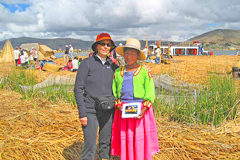
Just about everywhere you look in Cusco – once capital of the Inca Empire, and South America’s oldest continuously inhabited city – you’ll see traces of its Incan past and its importance to the Inca people as the “navel of the world,” as well as of the early Spanish colonial city built above it. Begin the day with a walk through the bustling modern-day market. Discover the ruins of the fortress of Sacsayhuaman, “the House of the Sun,” an important Inca stronghold. Nowhere is the collision between the European and Inca cultures more apparent than at the Baroque Convent of Santo Domingo; after the Inca Temple of the Sun at Koriqancha was ransacked by Spanish conquerors, its amazing stone walls became the foundation for the convent, built atop the temple. The 16th-century Cathedral of Cusco, whose massive altar is made of solid silver, is a splendid example of Spanish colonial churches in the “New World.” Perhaps you’ll hear the tolling of the Maria Angola bell, the largest in South America, during your visit, as your local guide shares insights about the conversion of Incan sites to Spanish churches.
Day 9 – Into the Andes
Board the Andean Explorer for a spectacular rail journey meandering through majestic peaks and across the Andean plains from Cusco to the shores of Lake Titicaca, the most sacred lake in the Inca world. Settle in for a pleasant and leisurely ride aboard your vintage rail car in the style of Europe’s famous Orient Express; lunch and afternoon tea will be served on the train. Spend the next two nights lakeside at Libertador Lake Titicaca Puno Hotel; the region’s only five-star hotel, this lovely property on Isla Esteves provides wonderful views of the world’s highest navigable lake.
Day 10 – Lake Titacaca 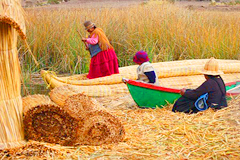
Legend has it that the Inca Empire began at Lake Titicaca when the sun god summoned his children from its chilly waters and sent them forth to establish Cusco. Centuries later, some of the indigenous people of the area – the Uros – dwell on forty-five Islas Flotantes de los Uro, floating islands made from reeds that dot the lake, living much as their ancestors did and still following their ancestral customs. View and visit some of these islands by boat, going ashore to meet the inhabitants. Later, on Taquile Island, visit the home of an Aymara family who will prepare lunch for you and perform some of their traditional dances. You’ll no doubt notice that on Taquile all the men seem to be industriously knitting, and you’ll see some of the items that they produce.
Day 11 – On the Bolivia
Begin the day with a drive along the coast of Lake Titicaca, then head across the lake via hydrofoil to Sun Island, Bolivia, the legendary birthplace of the Incas. The ancient Aymara and Quechua peoples believed that the sun and the gods were born here and founded the Inca Empire. Many of their descendants still hold that belief; the only means of transportation between the five villages on the island, home to about 5,000 people, is the donkey. Savor a typical Bolivian lunch against the scenic backdrop of Titicaca’s blue waters, its many islands, and the snow-capped Andes beyond. Hop back aboard the hydrofoil and pass through the narrow Straits of Tiquina to Huatajata, where you’ll stop at the museum of the Limachi family, builders of the reed boats, used by famed explorer Thor Heyerdahl to prove his theory that ancient vessels could cross vast oceans. Continue overland to La Paz, the highest capital city on Earth, for a two-night stay.
Day 12 – La Paz 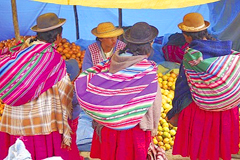
La Paz, founded in 1548 by Spaniards, is the highest capital city in the world above sea level. Venture just outside the city to explore the lunar-like badlands dubbed the Valley of the Moon, a stone landscape of deep gullies and bizarre rock formations, before heading to La Paz’s city center to soak up some local color in the bustling Indian Market. Browse in the Witches’ Market for magic amulets, potions, spells or plants reputed to have healing powers. From the Plaza Murillo, you’ll see the colonial-era Government Palace, known as the Burned Palace because it was set on fire during eight different revolutions; the Congress building had been a convent, a jail and a university before being renovated in 1904 to house the congress of Bolivia. At Bolivia’s National Art Museum enjoy a farewell reception, including a private tour of the museum, followed by dinner.
Day 13 – Adios
Your tour ends in La Paz.
